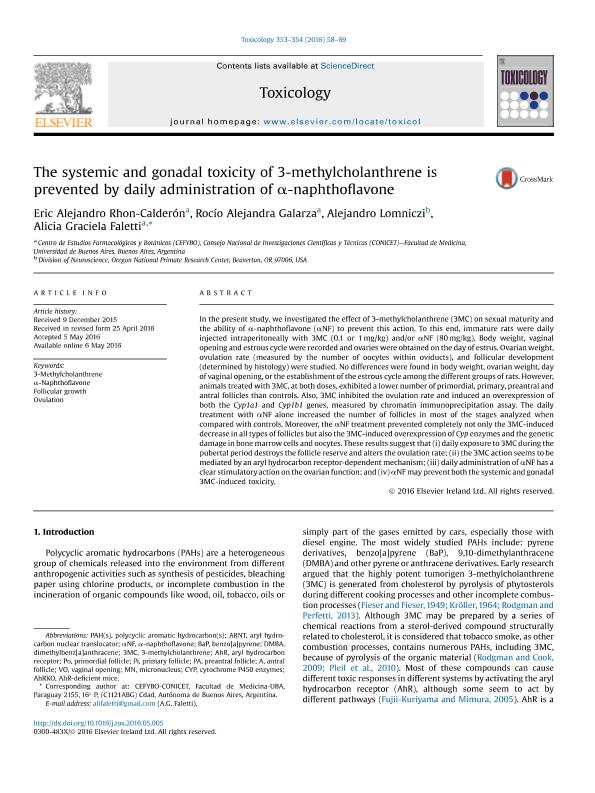Mostrar el registro sencillo del ítem
dc.contributor.author
Rhon Calderón, Eric Alejandro

dc.contributor.author
Galarza, Rocío Alejandra

dc.contributor.author
Lomniczi, Alejandro
dc.contributor.author
Faletti, Alicia Graciela

dc.date.available
2018-03-15T17:08:57Z
dc.date.issued
2016-04
dc.identifier.citation
Rhon Calderón, Eric Alejandro; Galarza, Rocío Alejandra; Lomniczi, Alejandro; Faletti, Alicia Graciela; The systemic and gonadal toxicity of 3-methylcholanthrene is prevented by daily administration of α-naphthoflavone; Elsevier Ireland; Toxicology; 353-354; 4-2016; 58-69
dc.identifier.issn
0300-483X
dc.identifier.uri
http://hdl.handle.net/11336/38925
dc.description.abstract
In the present study, we investigated the effect of 3-methylcholanthrene (3MC) on sexual maturity and the ability of α-naphthoflavone (αNF) to prevent this action. To this end, immature rats were daily injected intraperitoneally with 3MC (0.1 or 1 mg/kg) and/or αNF (80 mg/kg). Body weight, vaginal opening and estrous cycle were recorded and ovaries were obtained on the day of estrus. Ovarian weight, ovulation rate (measured by the number of oocytes within oviducts), and follicular development (determined by histology) were studied. No differences were found in body weight, ovarian weight, day of vaginal opening, or the establishment of the estrous cycle among the different groups of rats. However, animals treated with 3MC, at both doses, exhibited a lower number of primordial, primary, preantral and antral follicles than controls. Also, 3MC inhibited the ovulation rate and induced an overexpression of both the Cyp1a1 and Cyp1b1 genes, measured by chromatin immunoprecipitation assay. The daily treatment with αNF alone increased the number of follicles in most of the stages analyzed when compared with controls. Moreover, the αNF treatment prevented completely not only the 3MC-induced decrease in all types of follicles but also the 3MC-induced overexpression of Cyp enzymes and the genetic damage in bone marrow cells and oocytes. These results suggest that (i) daily exposure to 3MC during the pubertal period destroys the follicle reserve and alters the ovulation rate; (ii) the 3MC action seems to be mediated by an aryl hydrocarbon receptor-dependent mechanism; (iii) daily administration of αNF has a clear stimulatory action on the ovarian function; and (iv) αNF may prevent both the systemic and gonadal 3MC-induced toxicity.
dc.format
application/pdf
dc.language.iso
eng
dc.publisher
Elsevier Ireland

dc.rights
info:eu-repo/semantics/openAccess
dc.rights.uri
https://creativecommons.org/licenses/by-nc-nd/2.5/ar/
dc.subject
3-Methylcholanthrene
dc.subject
Follicular Growth
dc.subject
Ovulation
dc.subject
Α-Naphthoflavone
dc.subject.classification
Toxicología

dc.subject.classification
Medicina Básica

dc.subject.classification
CIENCIAS MÉDICAS Y DE LA SALUD

dc.title
The systemic and gonadal toxicity of 3-methylcholanthrene is prevented by daily administration of α-naphthoflavone
dc.type
info:eu-repo/semantics/article
dc.type
info:ar-repo/semantics/artículo
dc.type
info:eu-repo/semantics/publishedVersion
dc.date.updated
2018-03-15T14:11:11Z
dc.journal.volume
353-354
dc.journal.pagination
58-69
dc.journal.pais
Irlanda

dc.description.fil
Fil: Rhon Calderón, Eric Alejandro. Consejo Nacional de Investigaciones Científicas y Técnicas. Oficina de Coordinación Administrativa Houssay. Centro de Estudios Farmacológicos y Botánicos. Universidad de Buenos Aires. Facultad de Medicina. Centro de Estudios Farmacológicos y Botánicos; Argentina
dc.description.fil
Fil: Galarza, Rocío Alejandra. Consejo Nacional de Investigaciones Científicas y Técnicas. Oficina de Coordinación Administrativa Houssay. Centro de Estudios Farmacológicos y Botánicos. Universidad de Buenos Aires. Facultad de Medicina. Centro de Estudios Farmacológicos y Botánicos; Argentina
dc.description.fil
Fil: Lomniczi, Alejandro. Oregon National Primate Research Center; Estados Unidos
dc.description.fil
Fil: Faletti, Alicia Graciela. Consejo Nacional de Investigaciones Científicas y Técnicas. Oficina de Coordinación Administrativa Houssay. Centro de Estudios Farmacológicos y Botánicos. Universidad de Buenos Aires. Facultad de Medicina. Centro de Estudios Farmacológicos y Botánicos; Argentina
dc.journal.title
Toxicology

dc.relation.alternativeid
info:eu-repo/semantics/altIdentifier/doi/http://dx.doi.org/10.1016/j.tox.2016.05.005
dc.relation.alternativeid
info:eu-repo/semantics/altIdentifier/url/https://www.sciencedirect.com/science/article/pii/S0300483X16300452
Archivos asociados
